Deep breaths. You can do this. You can do this.
Good god, but it’s difficult. Escape From Monkey Island, while not exactly plumbing the same depths as the truly awful LucasArts adventures like Zak McKraken and Fate of Atlantis, still does not make itself a particularly easy game to like, or to play. I am not entirely sure what was going on with the personnel situation at LucasArts while it was being made, but the feeling I get when playing it is the same one I experienced when playing Mass Effect Andromeda, or the single-player campaign of Halo Infinite, where the teams responsible for the original classics had long since moved on and their replacements were trying to put together a sort of cargo-cult copy without understanding how or why anything in the originals worked. Escape feels like the most expensive Monkey Island fan game ever made, and while I don’t have the phrase “fan game” down in my lexicon as a pure pejorative, when I apply it to a product made by the professionals at LucasArts, the supposed masters of the adventure game genre, I definitely mean it as one.
It’s not like I didn’t go into it with an open mind. I have played through Escape exactly once, when it first came out in 2000, and while I thought it was incredibly average in comparison to Curse and there were some bits that seemed spectacularly idiotic even to 16-year-old me (like Monkey Kombat), I didn’t hate it. Sure, the discourse turned against it during the subsequent decades and I had my opinion partially poisoned by groupthink that it was actually a disaster of a game, but set against that is… well, I have played some real fucking stinkers as part of this series, and also Chinatown Detective Agency earlier this year, so my scale for what constitutes a truly crap adventure game has been appropriately recalibrated. In spite of its reputation I wasn’t expecting Escape to be that bad, just incredibly underwhelming, and gave it the fairest go I possibly could.
Only to find that, no, it really does just suck.
Story-wise, Escape From Monkey Island is a (sort of) direct sequel to Curse, in so much as that actually matters for a series of comedy pirate-themed adventure games. Having reversed the curse of the diamond ring and defeated the ghost pirate LeChuck for a third time, series protagonist Guybrush Threepwood marries Elaine and spends the next three months on a pirate honeymoon… only to return to Melee Island and discover that he and Elaine have been declared dead, Elaine is being challenged in the gubernatorial elections by a slimy politician called Charles L Charles (hmm, I wonder who this could be?), and that the Carribean generally is being taken over by an unscrupulous Australian business magnate called Ozzie Mandrill, who is driving out all of the pirates and replacing them with tacky pirate-themed tourist traps like Starbuccaneers and Planet Threepwood.
And straight away we have a problem. I like the Monkey Island series because, while it’s ostensibly very stupid and self-referential and not afraid to break the fourth wall at all, it’s usually quite clever about how it does it. The first game was the best at leveraging this, being full of anachronistic jokes about the extremely theme park-y nature of its world (as well as adventure games in general), but they were always delivered with the narrative equivalent of a knowing wink because the writing assumed the player was smart enough to already be in on said jokes without over-explaining them. You have isolated absurdities like the grog machine and the piranha poodles and the guy in the troll costume who eats the red herring, and there are a lot of them, but they’re isolated; most of the time the game is paying just enough lip service to its pirate theming to maintain kayfabe, because these anachronisms are only funny if they’re actually anachronisms — i.e. genuinely out of place given the context of the surrounding world.
But where Monkey Island’s story and humour was stupid in a clever way, Escape From Monkey Island’s story and humour is just stupid in a stupid way. This is not a pirate-themed adventure game with a lot of modern-day references, this is a modern-themed (or at least 2000s-era modern) adventure game that occasionally remembers that it was supposed to have pirates in it at one point. When nearly everything in the game is something ripped directly from the real world, the anachronisms cease to be remarkable — they’re just normal, at that point. Why is the idea of a Starbuccaneers funny if it’s on an entire island full of chain restaurants and microbreweries and real estate offices? If everything in your game is absurd and ridiculous, then nothing is; it’s just business as usual, which is kind of a problem when this is the only joke that Escape really knows how to do. And if you’re so insecure that you have to explain that joke up front, again and again, then you’re a terrible comedian. This is the exact same mistake the end of Monkey Island 2 made, except applied to an entire game, and it is absolutely awful.
So Escape, by its very nature, is a game that’s laser-targeted to piss me off, with absolutely none of the exceptionally self-assured dry humour of the games it’s supposed to be following up, and which failed to make me laugh even once. This time around, though, there was something that felt awfully familiar about the way it was going about this. Escape features:
- An obsession with Americana and tourism.
- Incredibly US-centric humour that has all of the subtlety and sophistication of a fart machine.
- An Australian villain.
And yet I didn’t manage to connect the dots until a friend explicitly pointed this out: the lead designers on Escape From Monkey Island are the same criminals responsible for Sam & Max. Everything fell into place after that; Escape From Monkey Island has far more in common with Sam & Max – a game that I intensely disliked — than it does the Monkey Island series, to the point where it isn’t so much Monkey Island 4 as it is the Sam & Max sequel that Sean Clark presumably hadn’t been allowed to make.
This goes a long way towards explaining why Escape is the way it is. Perennial series villain LeChuck is stuck playing second fiddle to an incredibly boring pisstake of Rupert Murdoch because the Sam & Max designers think Australia and Australians are inherently funny. Spoiler: they are not, and the uncharitable part of me strongly suspects that the designers and writers of Escape From Monkey Island had never travelled outside of the continental United States, because that’s the only way you could find the mere concept of an Australian accent side-splittingly hilarious. This would also explain why Escape appears to be a game targeted solely at the US market; LucasArts games have always had this problem where a lot of the humour is dependent on having at least a surface-level understanding of US history and culture, but Escape takes it to another level entirely. Even now, twenty-two years later, there are lines in Escape that are clearly structured like jokes, and which are clearly meant to be funny, but which remain largely impenetrable to me because they’re only parsable by people who grew up in the US in the 80s and 90s. The Marco Polo “joke” is the best example of this — I think it’s a game (or hazing ritual) in American schools, but that’s only my best guess based on the context it’s presented to me in, and even with that knowledge I don’t understand why the joke is supposed to be funny.
(Of course I’m overlooking the most obvious explanation here: that the joke simply isn’t very good.)
The really weird thing about Escape being the most insular LucasArts adventure game of them all is that Curse undersold in the US — the entire series historically undersold in the US — and Wikipedia tells me that Escape would not have been made if not for strong sales of Curse in Germany. When the game performs so poorly in the US market, why are you cutting out everyone who lives outside of it — i.e. the people who bought your game in the past, and who you are hoping will show up to buy the sequel — from half of the jokes? And then the other half are just absolutely insipid, lowest common denominator stuff. We have some charming 2000-era joking around disabled people and the use of politically-correct language, Guybrush complains on multiple occasions because he’s been given a pink ship, and the portrayal of Guybrush and Elaine as a married couple is one step away from deploying words like “ball and chain”. This wouldn’t have raised too many eyebrows at the time but coming back to it in 2022 is pretty cringeworthy stuff; when the figurehead of Guybrush’s ship comes alive and starts talking to him it’s actually a relief that it’s only used to hit you around the head with a Titanic reference (that I already got thanks to the figurehead’s pose) instead of anything mildly sexist or ableist.
I’d like to say that the Sam & Max connection also explains why Escape is such a startlingly ugly game, but this is something that makes a little less sense than the rest of it. Both Sam & Max and Escape are massively overfond of every single character in the game being a grotesque caricature that is thoroughly unsettling to look at and unpleasant to talk to. In Escape’s case this is at least partly because of the limitations of the 3D models; where Grim Fandango wisely chose to populate its world with a cast of stylised skeletons that didn’t have a huge amount of model detail, Escape has to figure out how to render a convincing pirate using technology that honestly feels pretty primitive even for 2000. Guybrush is the only character drawn in a semi-straightforward style and he might be the worst of the lot; he has none of the expressiveness of his prior incarnations, and so you spend most of the game in the company of an empty-eyed mannequin wearing a constant idiotic smirk. Given how he turned out I can somewhat understand the more extreme cartoonish stylisation of the various NPCs he meets along the way, but the overall choices made are baffling: the game is full of too-long noses, too-wide smiles and proportions straight out of a Hellraiser movie that make me wonder if I’m going to be meeting any of these characters in my nightmares later.
And Escape’s handling of its pre-rendered 2D backdrops gives me a new appreciation for Grim Fandango’s. Sure, they haven’t aged well in places, but there was an artistic vision driving most of Grim Fandango (except for the brown bits) that occasionally transcended the limitations of late 90s CG artwork and which somewhat insulated the rest of it from the passage of time. By contrast Escape’s backdrops are best described as the CG equivalent of drawings in Microsoft Paint, because they have no imagination. Every building is a square box with a sign on it telling you what it is. Every interior is the same collection of brown walls and brown flooring and brown stairs and brown railings and brown furniture. In the rare event that the game chooses to insert some detail into an environment, it’ll self-sabotage by using Comic Sans (or an adjacent font) for its lettering. The only thing that really stands out is the signature Monkey Island cloud artwork, and even this just serves to highlight how crap the rest of it is by its sheer incongruousness. It’s only when you get to Monkey Island itself in the third act of the game that the game steps outside of the Brown paradigm; it’s here that the one mildly impressive environment is to be found, with the stained glass windows in the Church of LeChuck serving as the only real creative outlet for an art team that used to be regarded as the best in the industry. This is not a world that I want to spend any time in, and Escape From Monkey Island as a whole is quite possibly the ugliest LucasArts adventure since Zak McKraken.
So the writing sucks and it’s no fun to look at, but what about the puzzles? Well, the best thing I can say about Escape’s puzzles is that, having played through the entire LucasArts adventure game catalogue now, they’re not quite as bad as they could have been. There is a tenuous thread of logic that runs through most of them, and while that logic is often cartoon logic (these are the same people who made Sam & Max, after all), it wasn’t that often that I was stymied by a complete non-sequitur of a solution. Guybrush still gives verbal hints as to what you’re supposed to do, and while these aren’t as helpful as the ones from Curse they’re usually enough to stop you straying too far in your thinking. There is one extremely notable exception to all this that I’ll get into in just a moment, and there are a few other blips that I could call out if I really wanted to (like the manhole cover and the parrots) but on the whole I think Escape’s puzzles are, while incredibly tedious, also reasonably inoffensive; the real problem with them is that they’re usually trying to be funny in some way, and Escape’s constant failure to actually be funny just ends up being sad, after a while. Because they’re not funny they just come across as the tedious make-work that adventure game puzzles ultimately are; since I didn’t care about the story and they weren’t making me laugh, and also because the GrimE engine has really cut down on the potential for custom animations or interface fuckery, solving them was a comparatively mundane process that carried zero weight or sense of accomplishment. It was just a series of boring, joyless tasks, and then once I’d finished them the game was over.
Anyone who has been unfortunate enough to play Escape themselves can probably guess what the exception is though; two words guaranteed to strike fear into the heart of any Monkey Island series veteran: Monkey Kombat. This is Escape’s take on Insult Swordfighting, a series “tradition” that has at this point been run so far into the ground it can probably start mining for rare earth minerals. Unlike most people I’ve hated Insult Swordfighting ever since it appeared in the first Monkey Island; it’s a puzzle that’s mostly reliant on trial and error as you gather the insults and their responses, but Monkey Kombat goes one step further and makes itself entirely reliant on trial and error. Because this is 2000, and because the writers of Escape are a collection of the least funny people on the face of planet Earth, Monkey Kombat is an entire game system predicated on the idea that the player will laugh and laugh and laugh when they see Escape has included a parody of Mortal Kombat. Guybrush fights a collection of monkeys by assuming one of five stances, and each stance can beat two of the four other stances. But he doesn’t know which stances beat which to start with, and he also doesn’t know which button combinations move from stance to stance, and he has to gather this by repeatedly losing to the monkeys while the player painstakingly generates a list of the 25 possible stance combinations and the button presses required to win each one. There are no jokes in Monkey Kombat besides the name, as the button presses correspond to monkey noises (“Oop! Ack! Chee!”) instead of “witty” repartee, and so all it is is a pure time sink. Escape From Monkey Island clocks in at a whopping six hours long, and a full half an hour of that was Monkey Kombat. It’s the single biggest factor in my rating of Escape dropping from “not as bad as Zak McKraken” to “almost as bad as Zak McKraken”.
(And just in case you’re thinking “Well, if making the list of stances is so boring, why not just look it up on the internet?” LucasArts are way ahead of you, since Monkey Kombat is one of several puzzles in Escape where the solution is randomised per playthrough to ensure that the player has to endure the sheer tedium of it.)
As tedious as the puzzles are, though, they’d be even worse if not for the improvements made to the GrimE engine. If I had had to play Escape with Grim Fandango controls I would not have made it to the end; it’s the longest LucasArts adventure game of them all, and having to deal with that crap for six hours is completely out of the question, especially when I’m playing the original release and not a fancy remaster with point-and-click controls that could be optionally invoked to sand off some of the rough edges, as I was with Grim Fandango. Fortunately while LucasArts may have forgotten how to write or structure an adventure game, with Escape they did belatedly remember some of the quality-of-life lessons they’d learned after making 11 games in the SCUMM engine:
- The biggest one is listing all objects in proximity to Guybrush at the bottom of the screen and letting you page through them with Page Up/Down to select the one you want him to interact with, which probably shaved around an hour off the game’s running time because I wasn’t wasting any of it accidentally interacting with the wrong item as I did in Grim Fandango, repeatedly.
- The inventory is still something that you scroll through one item at a time, but in Escape you can at least see the entire inventory while you’re scrolling and quickly get to the item you want.
- There are once again dedicated keyboard buttons to Use and Pick Up objects instead of having to rely on the blunt instrument of Interact for the entire game, and — a godsend — an additional Outside command that immediately teleports you either outside the building you’re currently in, or out of the settlement to the world map
These improvements are still nowhere near providing the precision and convenience of the final tranche of SCUMM games, but they are appreciated nevertheless, and if Grim Fandango had had these extra features I think I would have liked it a lot more.
Otherwise I think the only part of Escape that really pulls its weight is the music. This is not outstanding by LucasArts standards — it’s severely handicapped by the best tracks having obnoxious background ambience baked into the sound files — but it sounds like Monkey Island and makes for a perfectly pleasant listen. I was even surprised to find that I remembered some of it, like the Lucre island theme; it had been buried in my brain for over two decades, but as soon as I heard the first few bars the rest of it came flooding back. There aren’t that many standout tracks, but what’s here is good nevertheless and I think I was just surprised to find something to like about Escape since the soundtrack is so much better than the game it’s unfortunately stuck in.
(Oh, and while we’re on the subject of sound stuff: Dominic Armato returns as Guybrush but there’s a weird desperation to his voice acting performance in this game, like he’s a struggling improv comedian who really wants people to laugh at his jokes. This is at least in keeping with the tone of the rest of the game, and I can’t exactly say I blame him since I don’t think there’s anyone out there that could make this material work.)
About the best thing that I can say about Escape From Monkey Island is that it’s not quite the worst LucasArts adventure game ever made. As unfunny as it is, as ugly as it looks, and as boring as its puzzles might be, I think that if you gave me a choice between playing Escape or playing Fate of Atlantis or Zak McKraken again I would probably still pick Escape. It’s a very close-run thing, though, and a damning indictment of LucasArts that, with all of their experience and talent, the last adventure game they ever made was also one of their worst. My piece on Curse already covered the wider reasons why adventure games were becoming increasingly unprofitable to make in the late 90s, but I think Escape is sufficient evidence that even if this were not the case, LucasArts were still starting to lose their grip on the genre thanks to technological changes and employee churn. It’s probably for the best that Escape was their final adventure game. As it is they get to be fondly remembered as the once-mighty titans of the adventure game genre, a studio known for top-notch production values and who were not content to rest on their laurels; one thing I’ve learned from this series is that LucasArts were always trying new things in an attempt to keep things fresh and maintain consumer interest, and while this produced games of wildly varying quality I could almost always find something to like about them. A few more games like Escape, though, and I think their reputation would have gone straight into the toilet the way Bioware’s has today.
—————————
Two years and thirteen games later and I’m finally done with this series. If nothing else it’s been very educational and has filled in some long-standing gaps in my gaming knowledge. I’ve been doing this blog for ten years now and I think this is the first one of these dedicated series I’ve actually managed to finish, and I’m happy to be able to finally draw a line under the LucasArts adventure games — after all, they’ve been dead for nearly as long as this blog has been alive, and surely nobody in their right mind would release a brand new adventure game using LucasArts IP in 2022?
Ah, shit. Here we go again…

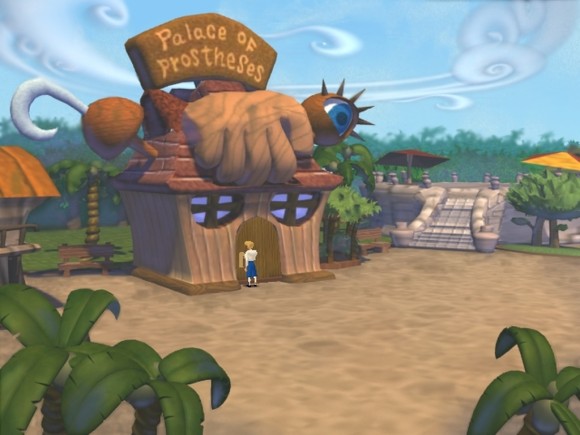
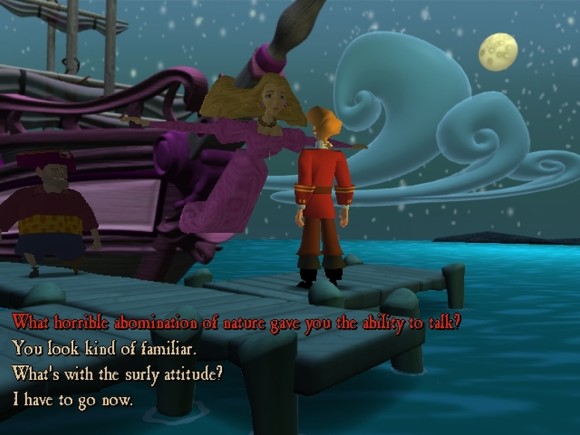
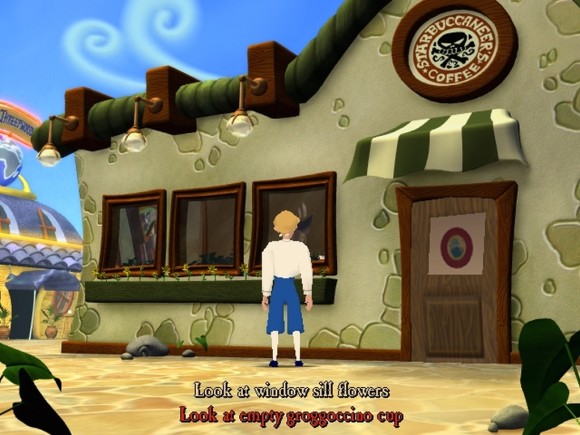
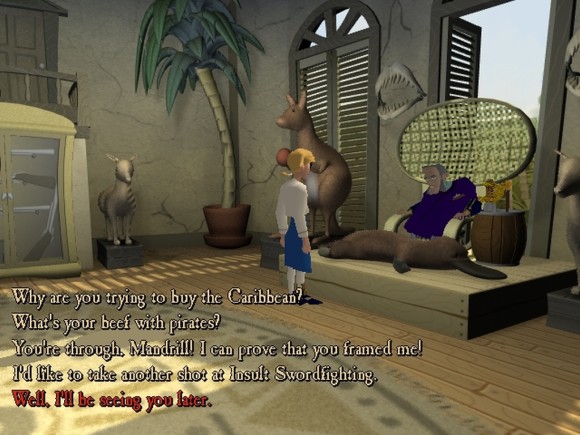
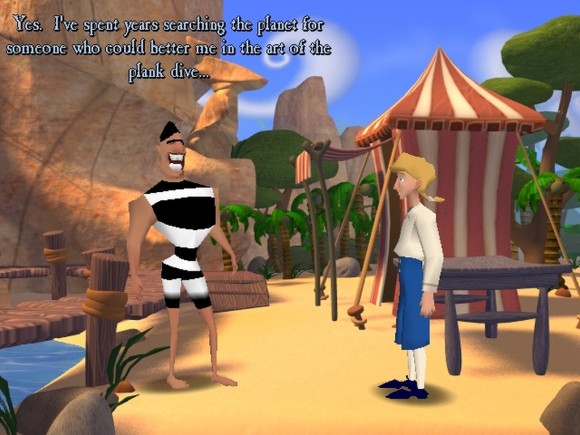
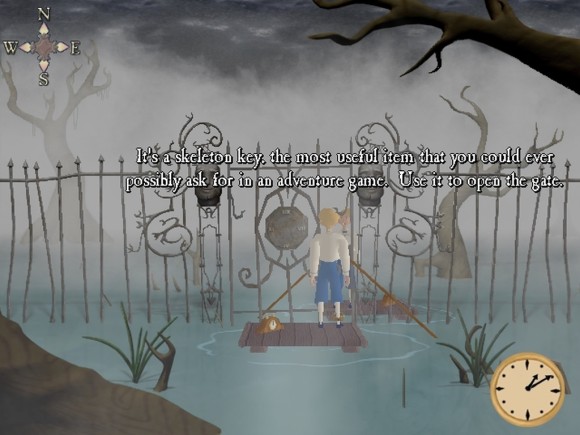
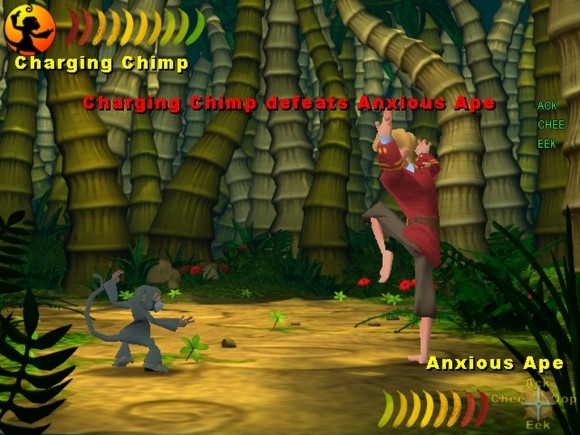
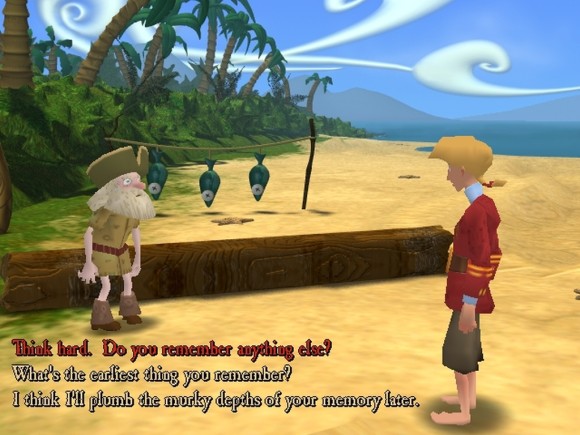
Wait, are you noy going to play Tales of Monkey Island?
I’m actually replaying Escape right now myself as part of catching up for the new one. I actually think it’s the funniest game in the series despite the weak tea of the anti-tourism stuff. The sound editing is punchier than in Curse, and the 3D models, despite being heinously ugly, let them make much faster, snappier animations than 2D sprites ever allowed.
But yeah, the puzzles are all over the place. The infamous filing system puzzle is a masterclass in bad design, making a relatively simple puzzle impossible to figure out simply because of presentation. And there are plenty of puzzles, like getting the blue painting, where they take a perfectly logical solution and then add an inexplicable extra step.
Apparently the new one is retconning Herman Toothrot as Elaine’s grandfather, but I still think that nicely tied up some narrative loose ends.
Anyway, a good analysis as always!
Big congratulations on finishing this series! Can’t believe I’ve been following it for that long as well!
By all accounts the new one is a return to form, but given your extensive analysis, where it seems others have remembered the series as being much stronger than it actually was, I’m not sure that means anything. Look forward to your thoughts.